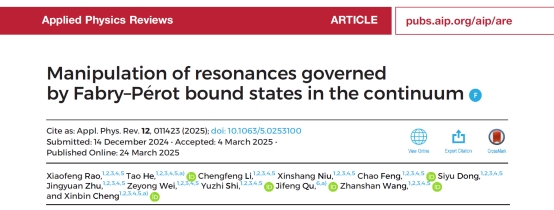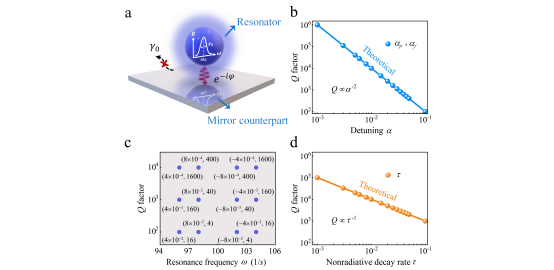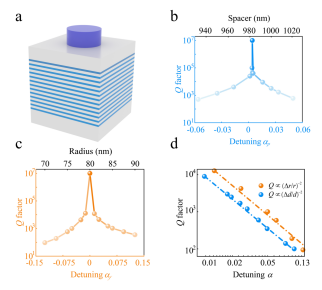Recently, the research team of Zhanshan Wang and Xinbin Cheng from School of Physics Science and Engineering, in collaboration with Jifeng Qu from the China Academy of Measurement Sciences, have realized the directional manipulation of resonances governed by Fabry-Pérot Bound States in the Continuum. Their research findings, titled “Manipulation of Resonances Governed by Fabry-Pérot Bound States in the Continuum”, have been published in Applied Physics Reviews and selected as a Featured Article in the current issue.

Bound states in the continuum (BICs) have provided a new paradigm for achieving extreme field localization and enhanced light-matter interactions in metasurfaces, as it is theoretically possible to achieve infinite quality (Q) factors. The most extensively studied “symmetry-protected BICs” typically necessitate the disruption of structural symmetry to transform BICs into quasi-BICs (QBICs), which can be excited and accessed through far-field excitation. In symmetry-protected BICs, the Q factor is inversely proportional to the square of the asymmetry parameter, and this evolution law has greatly contributed to the progress of symmetry-protected BICs in the fields of biosensing, nano-lasers, and nonlinear enhancement, etc. FP-BICs, as another class of BICs, are also of high research value. However, the lack of systematic understanding of quasi-FP-BICs, particularly the evolution law of Q factors, poses challenges in the directional design of FP-BIC resonances, significantly impeding their development and applications.

Figure 1. Model and evolution law of Q factors of FP-BICs
To tackle these challenges, the research team of Zhanshan Wang and Xinbin Cheng from School of Physics Science and Engineering, in collaboration with Jifeng Qu from the China Academy of Measurement Sciences, have proposed a interlayer coupled resonators model (Fig. 1(a)), which theoretically and rigorously deduces the evolution law of the Q-factor of FP-BICs under perturbation, reveals that the Q factor is inversely proportional to the square of phase/frequency detuning (Fig. 1(b)), and to the nonradiative decay rate (Fig. 1(d)), enabling directional engineering of FP-BICs resonances (Fig. 1(c)). Further, the team introduce a new framework comprising metasurface and multilayer films (Fig. 2(a)) to induce FP-BICs and prove the evolution law of FP-BICs. This paradigm relies on the coupling between an optical resonator realized by the metasurface and its perfectly mirrored counterpart achieved by multilayer films. By varying the spacer layer to simulate phase detuning (Fig. 2(b)) and varying the radius of the metasurface unit to simulate frequency detuning (Fig. 2(c)), the final fit results exhibit good agreement with the theoretical results (Fig. 2(d)).

Figure 2. The evolution of Q factors based on multilayer film metasurfaces
In addition, the paper experimentally demonstrates the effect of frequency detuning on the resonant frequency and Q-factor of quasi-FP-BICs, where the reflection spectra of the multilayer films prove that it can be well realized as a perfect reflector. By measuring the reflection spectra of these multilayer film metasurfaces, it is observed that the resonant wavelength of the quasi-BICs redshifts and the Q-factor decreases up to a maximum Q-factor of 610 as the diameter of the metasurface cells increases.
This work established the intrinsic relationship between the Q factors of FP-BICs and both phase/frequency detuning and nonradiative decay rates for the first time. The Q factors of FP-BICs exhibit an inverse proportionality to the square of phase/frequency detuning and an inverse proportionality to the nonradiative decay rate. By introducing a multilayer film metasurface, theoretically and experimentally demonstrated the evolution law of the Q factor of FP-BICs in the visible region. This work establishes a theoretical foundation for the directional engineering of FP-BIC resonances and provides valuable insights into BICs, promising to stimulate exotic phenomena and applications.
PhD candidate Xiaofeng Rao, Assistant Professor Tao He, and PhD candidate Chengfeng Li are co-first authors of the paper. Assistant Professor Tao He, Researcher Jifeng Qu, and Professor Xinbin Cheng are the co-corresponding authors. Postdoctoral Xinshang Niu, PhD candidate Chao Feng, Assistant Professor Siyu Dong, Assistant Professor Jingyuan Zhu, Associate Professor Zeyong Wei, Professor Yuzhi Shi, and Professor Zhanshan Wang have participated in the research work.
Paper link: https://doi.org/10.1063/5.0253100
